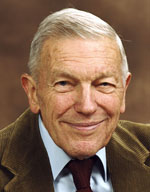Richard E. Norberg, PhD, retired professor and longtime chair of physics in Arts & Sciences at Washington University in St. Louis and a pioneer in using nuclear magnetic resonance (NMR) as a practical analysis tool, died April 20, 2010, at Bethesda Dilworth in St. Louis. He was 87.
Norberg was born in Newark, N.J., but grew up in Evanston, Ill., where his parents were public school teachers.

Norberg
He attended DePauw University in Greencastle, Ind., majoring in chemistry. His education was interrupted by World War II, in which he served in the U.S. Army Air Force from 1942-46. He graduated from DePauw in absentia in June 1943.
He earned a master’s degree in 1947 and a doctorate in 1951 in experimental physics, both from the University of Illinois at Urbana-Champaign.
He came to Washington University in 1954 as a visiting lecturer in physics and joined the faculty as an associate professor in 1955. He also became a member of the department’s NMR research group, under the direction of the late George E. Pake, PhD, physics professor and department chair. Norberg took over the NMR group in 1956 when Pake went to Stanford University.
Norberg, an Alfred P. Sloan Fellow from 1955-57, was named professor in 1958 and served as chair from 1962-1991, during which time there were major changes in the department. Those changes included the expansion of the faculty, development of new research areas and construction of the Arthur Holly Compton Laboratory of Physics, completed in 1965.
Norberg oversaw all aspects of the design — described as practical and flexible — of the five-story building that contains labs, offices and library space for physics.
Norberg’s research included the design and construction of analog computers; digital control systems; and magnetic resonance investigations of systems in condensed matter physics, materials research, biological physics and chemical physics.
His more recent research contributed to a better understanding of amorphous semiconductors, metal-hydrogen systems, quantum fluids and solids, impurities and defects in solids, and biological membranes.
Norberg was named a co-recipient of the 2004 ISMAR Prize, the highest honor the International Society of Magnetic Resonance awards. The award recognizes outstanding achievement in magnetic resonance science.
Norberg shared the prize with his former doctoral student Irving J. Lowe, PhD, also a noted authority in the field of magnetic resonance.
The International Society of Magnetic Resonance cited Norberg and Lowe for their discovery and demonstration of the Fourier transform method for obtaining NMR spectra in solids and for their contributions to the invention and demonstration of magic-angle spinning.
As John W. Clark, PhD, the Wayman Crow Professor of Physics and then chair of physics, said at the time of the award: “Dick Norberg has been a pioneer in the development and application of nuclear magnetic resonance as an incisive tool for the study of condensed-matter systems.”
His work helped lead the way to NMR becoming a practical analysis tool.
“In addition to his significant scientific achievements, Dick was an outstanding chairman of the Department of Physics, a dedicated mentor to 47 graduate students and the guiding force behind the design of Compton Laboratory of Physics,” said Michael Friedlander, PhD, professor of physics and a longtime colleague.
Norberg retired from full-time teaching in 1993, but he continued doing research and teaching part time until June 2003, and he remained active in the department until a few months ago.
A fellow of the American Physical Society, Norberg was on the Council of the International Society of Magnetic Resonance and was a member of the editorial board of the Magnetic Resonance Review. He also served as a consultant to a variety of corporations.
There will be no funeral service. Norberg requested that his body be donated to the Washington University School of Medicine. The university’s Department of Physics plans to hold a memorial service in the next few months.
He is survived by his wife, Jeanne O’Brien Norberg of University City, Mo.; a daughter, Karen Norberg, MD, of St. Louis and of Cambridge, Mass.; two sons, Craig Norberg-Bohm of Boston and Peter Norberg of Ferguson, Mo.; a stepson, Richard O’Brien of St. Louis; two stepdaughters, Kathleen O’Brien and Anne O’Brien, both of St. Louis; and six grandchildren. His first wife, Patricia L. Norberg, died in 1977.
His daughter, Karen, stepdaughter Kathleen, and sons, Craig and Peter, are WUSTL graduates, and Karen is a research instructor in psychiatry at the School of Medicine and senior research associate of WUSTL’s Center for Health Policy.
Memorial contributions may be made to the Jaynes Fund, which benefits the
Department of Physics at Washington University, Attn: Gary Kornell, A&S Development Office, Washington University, Campus Box 1202, One Brookings Dr., St. Louis, MO, 63130, or to the Union Avenue Opera, Attn: Dana Stone, Union Avenue Opera, 733 N. Union Boulevard, St. Louis, MO 63108.